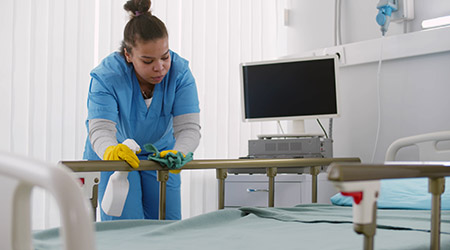The pandemic made the sanitation practices of healthcare facilities more stringent and creative. High-touch surfaces such as light switches or television remotes are consistently a top priority for these facilities. Disinfecting these areas is one part of the strategy to improve sanitation habits.
Some disinfectants require less time to sterilize a surface than others. In this Q&A with Dr. Saskia Popescu, an infectious disease epidemiologist and assistant professor within the Biodefense graduate program at George Mason University, Dr. Popescu suggests using disinfectants with short contact to effectively reduce the spread of pathogens.
Technology is also advancing the way healthcare spaces are disinfected. Electrostatic technology and UV-C lighting are two examples of the evolving practice that is healthcare facilities disease control.
HFT: What are the critical touch points in a patient room that EVS teams should disinfect?
Dr. Popescu: Within healthcare settings, it is important to perform the highest standard of care and focus on high-touch surfaces such as door handles, light switches, handrails, remotes, and countertops as well as high-risk areas such as patient care rooms. In patient care areas and rooms, EVS teams should focus on identifying the highest-touch surfaces as well. These can include, but are not limited to, surfaces like patient bed rails, patient chairs and chair handles, TV remotes, call lights, bathroom fixtures, control panels or knobs for equipment and transport equipment. Disinfecting high risk areas in healthcare settings is an important part of a holistic strategy to reduce the spread of pathogens, increase maximum protection from infections and optimize the use of disinfectants.
HFT: The floor is often overlooked. How frequently should EVS teams be disinfecting floors?
Dr. Popescu: As with any healthcare or non-healthcare facility, it is important to develop cleaning and disinfecting protocols informed by a risk-assessment to prioritize implementation in high-traffic and high-risk areas as well as identifying high-touch surfaces in your healthcare facility.
In regard to floors, similar to any other shared, commonly touched surface, we recommend disinfecting at least once a day, and more frequently depending on the level of risk.
HFT: Changeover of patient rooms sometimes needs to be done quickly, especially in the midst of a pandemic. What is the appropriate dwell time to give disinfectants?
When it comes to dwell time, also known as contact time, there is no hard and fast rule. It’s really about following recommendations of the product and, unfortunately, it can vary by formula and even by pathogen. It is important for end users to read and follow the product label instructions on each disinfectant you are using to determine the dwell time(s) as well as ensure proper and safe use.
For effective disinfection, it is imperative to keep the surface visibility wet for the full dwell time. If the surface dries before the dwell time is reached, the pathogens might not be completely killed. Moreover, one application may not be enough — some products require a second application to keep surfaces visibly wet for the full contact time. In order for healthcare facilities to combat this, we recommend using disinfectants with short contact times as much as possible in order to help turnover patient rooms efficiently yet effectively — this can also help reduce labor and product costs!
HFT: With the greater public awareness of the importance of disinfecting, are hospitals focusing on disinfecting waiting areas and lobbies more?
Dr. Popescu: In general, there is now heightened consumer expectations for what type of hygiene behaviors they expect to see in public spaces. The pandemic has shone a spotlight on proper cleaning and disinfecting.
In healthcare settings, cleaning and disinfecting has always played an important role given the high-risk nature of the setting. However, in my hospital and from what I have heard from colleagues of mine, the pandemic has certainly made us take a closer look across our protocols in other areas such as waiting areas, cafeterias, and lobbies to ensure they are as effective and efficient as possible.
HFT: What disinfecting should and shouldn't be done around occupants?
Dr. Popescu: It is common for nurses or EVS staff to disinfect some areas of a patient room, even when occupied, to help reduce the risk of germs living on frequently touched surfaces. Sinks, bed rails and door handles are examples. Typically, if a room is occupied, staff will use a ready-to-use wipe instead of a spray in order to minimize scents or droplets in the air. Disinfecting technologies like UV light, foggers, or electrostatic devices should only be used in unoccupied rooms.
HFT: There are more alternatives to traditional chemical disinfectants. Are there advantages to using emerging technology such as electrostatic sprayers and UV-C?
Dr. Popescu: Absolutely! While it is important to evaluate any technology you plan on implementing, electrostatic technology is a great tool that can be used safely and effectively to quickly apply EPA-approved disinfectants to surfaces, particularly those hard-to-reach areas that are difficult to clean and disinfect manually. Electrostatic technology allows the solution to wrap around the surfaces including those hard-to-reach areas, providing comprehensive and uniform coverage. This enables facilities to more quickly and more effectively disinfect surfaces.

 Building Sustainable Healthcare for an Aging Population
Building Sustainable Healthcare for an Aging Population Froedtert ThedaCare Announces Opening of ThedaCare Medical Center-Oshkosh
Froedtert ThedaCare Announces Opening of ThedaCare Medical Center-Oshkosh Touchmark Acquires The Hacienda at Georgetown Senior Living Facility
Touchmark Acquires The Hacienda at Georgetown Senior Living Facility Contaminants Under Foot: A Closer Look at Patient Room Floors
Contaminants Under Foot: A Closer Look at Patient Room Floors Power Outages Largely Driven by Extreme Weather Events
Power Outages Largely Driven by Extreme Weather Events